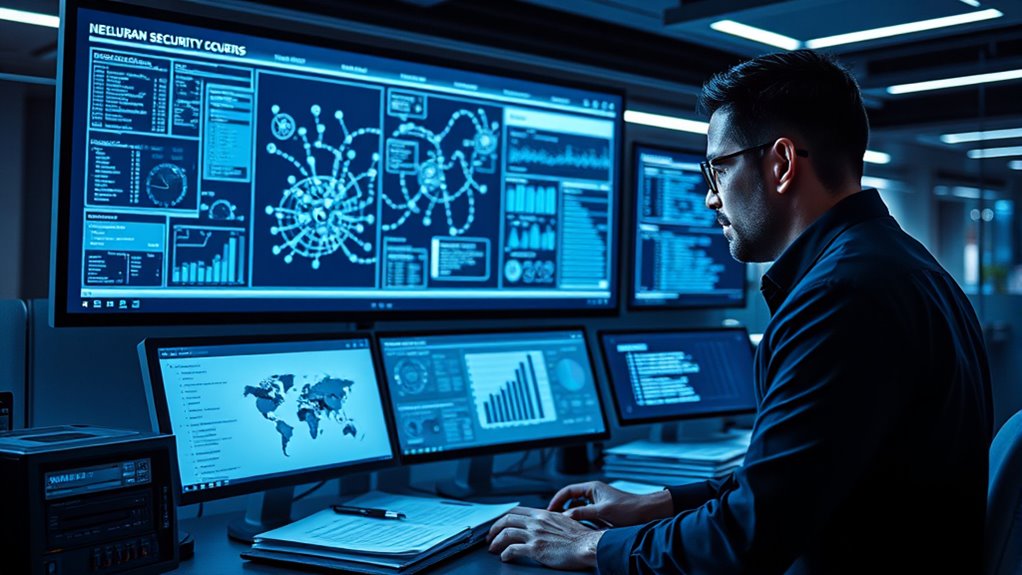The DHS Office of Intelligence & Analysis is your federal hub for detecting and preventing threats against the U.S. It collects, analyzes, and shares intelligence to keep communities safe. This office works closely with other agencies, private sector partners, and local authorities to identify risks early. Using advanced technology, it transforms data into actionable insights. If you keep exploring, you’ll discover how this essential team strengthens national and community security every day.
Key Takeaways
- The DHS Office of Intelligence & Analysis is responsible for collecting, analyzing, and sharing threat intelligence to protect U.S. communities.
- It collaborates with agencies like FBI, CIA, and local authorities to coordinate national security efforts.
- Utilizes advanced data analytics, cyber intelligence, and open-source tools to identify emerging threats.
- Focuses on threat detection, border security, and disrupting terrorist networks through proactive intelligence.
- Ensures timely and accurate dissemination of actionable intelligence to support prevention and response strategies.

Ever wondered how the Department of Homeland Security (DHS) keeps the nation safe? It’s largely through the dedicated work of the DHS Office of Intelligence and Analysis, which plays a pivotal role in safeguarding your communities. This office is responsible for collecting, analyzing, and sharing intelligence related to threats against the United States, especially those posed by terrorists and other malicious actors. To succeed, they rely heavily on effective counterterrorism strategies and close intelligence community collaboration. These efforts allow you to benefit from timely, accurate information that helps prevent attacks and respond swiftly when threats emerge.
The DHS Office of Intelligence and Analysis safeguards communities through intelligence sharing, counterterrorism, and collaboration.
When it comes to counterterrorism strategies, the DHS Office of Intelligence and Analysis acts as a central hub for identifying potential risks. They process intelligence gathered from various sources—government agencies, local authorities, private sector partners, and international allies—to spot patterns and indicators of terrorist activity. This proactive approach helps you stay ahead of threats before they materialize. By focusing on threat detection, border security, and the disruption of terrorist networks, they guarantee that intelligence isn’t just collected but turned into actionable insights. This continuous cycle of analysis and response is essential to protecting your safety and maintaining national security.
Integral to this process is intelligence community collaboration. The DHS works closely with agencies like the FBI, the CIA, and the Department of Defense, sharing intelligence and coordinating efforts across multiple levels of government. This collaboration ensures that information flows seamlessly, reducing gaps that potential terrorists could exploit. You benefit because the combined efforts lead to more thorough threat assessments and faster response times. The DHS Office of Intelligence and Analysis also partners with local law enforcement and private sector organizations, creating a layered defense that encompasses various facets of society. This interconnected network of intelligence sharing guarantees you’re protected not only at a federal level but also within your own community.
The office also emphasizes the importance of technology and innovation in counterterrorism efforts. They utilize advanced data analytics, cyber intelligence, and open-source monitoring to stay ahead of evolving threats. This technological edge enables them to sift through massive amounts of data efficiently, identifying risks that might otherwise go unnoticed. As a result, you gain a more resilient security environment. The DHS Office of Intelligence and Analysis’s work combines strategic planning, technological innovation, and inter-agency cooperation, all aimed at maintaining your safety and freedom from harm. Their vigilance and collaborative approach create a security framework that adapts to emerging threats, ensuring that you, your family, and your community remain protected against those who seek to do harm.
Frequently Asked Questions
How Does DHS I&A Coordinate With Local Law Enforcement Agencies?
You can see that DHS I&A coordinates with local law enforcement through strong interagency collaboration and intelligence sharing. They regularly exchange information, coordinate joint operations, and provide timely updates to make certain of national security. By working closely, they address threats more effectively, share resources, and develop unified strategies. This partnership helps local agencies stay informed and prepared, ultimately strengthening the overall security posture at both local and national levels.
What Are the Career Opportunities Within DHS Office of Intelligence & Analysis?
You can pursue careers in cybersecurity roles, where you’ll protect critical infrastructure from cyber threats, or emergency management positions, coordinating responses to national crises. DHS I&A offers diverse opportunities, including intelligence analysis, threat assessment, and operational support. These roles require strong analytical skills and a commitment to national security. If you’re passionate about safeguarding the nation, DHS I&A provides a pathway to meaningful, impactful work in various specialized fields.
How Does DHS I&A Prioritize Threats and Intelligence Needs?
You focus on threat assessment and intelligence prioritization to determine which issues need immediate attention. DHS I&A evaluates data from various sources, analyzing risks to identify the most pressing threats. They use intelligence prioritization to guide resource allocation and response strategies effectively. This process guarantees that you’re always working on the most critical security concerns, helping to protect the nation from evolving threats efficiently and proactively.
What Technologies Are Used for Data Collection and Analysis?
You rely on advanced surveillance sensors and data analytics to gather and interpret critical information. These technologies enable you to detect patterns, monitor threats, and respond swiftly. Surveillance sensors collect real-time data across various environments, while data analytics process vast amounts of information to identify anomalies. Together, they form a powerful toolkit that helps you stay ahead of emerging threats and make informed decisions efficiently and effectively.
How Does DHS I&A Ensure the Privacy Rights of U.S. Citizens?
You can trust that DHS I&A guarantees your privacy rights through strict privacy safeguards and oversight mechanisms. They implement policies to limit data collection to what’s necessary and regularly review their procedures. Oversight by internal and external bodies helps hold them accountable, ensuring they respect your rights while keeping the nation safe. These measures balance national security needs with your privacy protections effectively.
Conclusion
Like a vigilant lighthouse guiding ships through treacherous waters, the DHS Office of Intelligence & Analysis stands watch, illuminating hidden threats before they reach the shore. Your understanding of its role reveals how this steady beacon helps navigate the complex currents of national security. In this silent guardianship, the agency becomes a steadfast guardian in the fog, ensuring safety and stability remain on the horizon, even when the night seems darkest.









